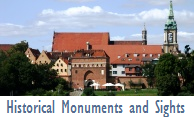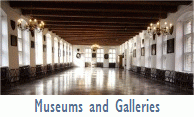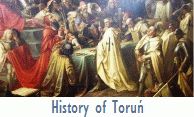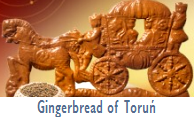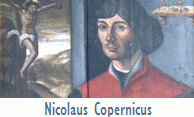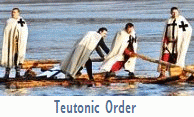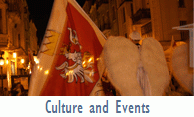|
World of Toruń Gingerbread (at Nicolaus Copernicus House)
Address: Opening hours: High season (May - September): Tue - Sun: 10am - 6pm | Mon: closed Low season (October - April): Tue - Sun: 10am - 4pm | Mon: closed Admission fees (without reservation charge): 11 PLN, reduced: 7 PLN Booking, further details: Toruński Serwis Turystyczny (Toruń Tourist Service), tel. (+48) 66 00 61 352, e-mail: pierniki@turystyka.torun.pl 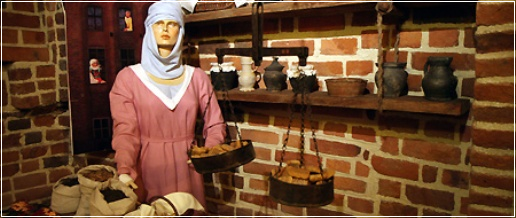 • More about Toruń gingerbread here.
i 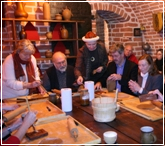 Do it on your own Do it on your ownVisit the 'World of Toruń Gingerbread' exhibition with our guides, who dressed in period attires will introduce you to the world of Toruń gingerbread by showing you around the exhibition, telling interesting stories, and baking ornamental gingerbread. Especially for you we have prepared the replicas of historic gingerbread baking trays. Not only will you visit the exhibition, but also you will have the chance to bake your own gingerbreads, and taste the ones produced by Fabryka Cukiernicza “Kopernik” S.A. (the Confectionery Factory). We would also like to invite you for evening gingerbread feasts, which can be accompanied with the sound and light show at the model of Toruń, or the theatre performance.
i 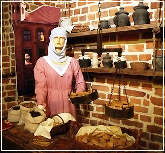 World of Toruń Gingerbread World of Toruń Gingerbread In the beautiful interior of the 15th century merchant house, typical for wealthy Toruń patriciate, you can visit the exhibition showing the everyday life of Toruń citizens on the turn of the 15th and 16th centuries. The stairs in the biggest room, the tall entrance-hall, lead you to the gothic cellars, where you can start visiting the exhibition presenting the history of famous Toruń gingerbread craft, which had its origins in the 14th century and flourished in the 17th and 18th centuries. The scenography arrangement lets you see the workshop of a gingerbread master, sitting at his desk and recording on wax boards stocks necessary for making honey and spice dough. Next to it there is the set of rules and regulations of the bakers' guild. Gingerbread bakers were its members as well since they
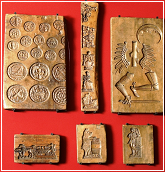 did not have their own organization. There are also chests for storing and transporting stocks. Apart from edible gingerbreads, bakers manufactured ornamental ones, with particularly sophisticated and beautiful artistic shapes. These luxurious goods meant for wealthy merchants were painted and gilded. Gingerbread dough was rolled into baking trays made of apple or pear tree wood. In the first room you can see mostly genuine blocks from the 17th and 18th centuries. They come from two Torun gingerbread workshops, which gave the origins to the biggest 19th century companies of Gustaw Weese and Hermann Thomas. In the chests we present baking trays from the north of Poland, from workshops in the towns of: Malbork, Nowy Dwór Gdański, Elbląg, and Pasłęk. These were the regional centres thriving in the shade of Toruń craft. The large collection of baking trays from Silesia region is exhibited separately. did not have their own organization. There are also chests for storing and transporting stocks. Apart from edible gingerbreads, bakers manufactured ornamental ones, with particularly sophisticated and beautiful artistic shapes. These luxurious goods meant for wealthy merchants were painted and gilded. Gingerbread dough was rolled into baking trays made of apple or pear tree wood. In the first room you can see mostly genuine blocks from the 17th and 18th centuries. They come from two Torun gingerbread workshops, which gave the origins to the biggest 19th century companies of Gustaw Weese and Hermann Thomas. In the chests we present baking trays from the north of Poland, from workshops in the towns of: Malbork, Nowy Dwór Gdański, Elbląg, and Pasłęk. These were the regional centres thriving in the shade of Toruń craft. The large collection of baking trays from Silesia region is exhibited separately. 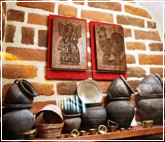 The District Museum in Toruń collection of gingerbread baking trays consists of 246 items. They are often carved on both sides. At the beginning of the 20th century , since 1908, the Town Museum had been completing the collection by numerous purchases and donations. After the Second World War the District Museum was still interested in gingerbread craft. The most invaluable gift that the Museum received is the collection of 26 baking trays from the 17th and 18th centuries, donated by Fabryka Piernikow i Wyrobów Cukierniczych "Kopernik" (the Factory of Gingerbread and Confectionery) in 1961. The District Museum in Toruń collection of gingerbread baking trays consists of 246 items. They are often carved on both sides. At the beginning of the 20th century , since 1908, the Town Museum had been completing the collection by numerous purchases and donations. After the Second World War the District Museum was still interested in gingerbread craft. The most invaluable gift that the Museum received is the collection of 26 baking trays from the 17th and 18th centuries, donated by Fabryka Piernikow i Wyrobów Cukierniczych "Kopernik" (the Factory of Gingerbread and Confectionery) in 1961. A contemporary visitor will be puzzled with the variety of themes carved in wood. The
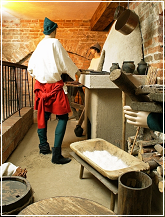 ones particularly popular, used both in Poland and Germany, were the images of gallants and ladies in beautiful 17th and 18th century attires. Their prevailing features are baroque opulence and accurate ornaments covering the whole carving surface. We can admire, for instance, a beautiful hunting scene hidden in plant themes, or a long board with the theme of four dolphins. The baking trays with the most popular themes, like a carriage, 'katarzynka' ('catherines'), or the coat of arms of Toruń cannot be missed either. You should also pay attention to the so called 'royal gingerbreads'. They were baked in special baking trays. There are four of them depicting two royal couples - King Zygmunt III with Konstancja and King Wladyslaw IV with Cecylia Renata. Unfortunately, the genuine 17th century baking trays were lost during the Second World War. Luckily, we have got gingerbreads baked in them in 1926. As luxurious goods, ornamental gingerbreads were meant as gifts for honourable guests. Apart from baking gingerbread, gingerbread bakers used to make marzipan figurines from grinded almond mixed with sugar, as well as tragant ones from sugar, starch, and edible rubber from astragalus tree. In the 18th century they were used as table decorations. Therefore, we have enriched the exhibition with two-part trays for manufacturing marzipan and tragant figurines. Occasionally these blocks were used for making gingerbread figurines. ones particularly popular, used both in Poland and Germany, were the images of gallants and ladies in beautiful 17th and 18th century attires. Their prevailing features are baroque opulence and accurate ornaments covering the whole carving surface. We can admire, for instance, a beautiful hunting scene hidden in plant themes, or a long board with the theme of four dolphins. The baking trays with the most popular themes, like a carriage, 'katarzynka' ('catherines'), or the coat of arms of Toruń cannot be missed either. You should also pay attention to the so called 'royal gingerbreads'. They were baked in special baking trays. There are four of them depicting two royal couples - King Zygmunt III with Konstancja and King Wladyslaw IV with Cecylia Renata. Unfortunately, the genuine 17th century baking trays were lost during the Second World War. Luckily, we have got gingerbreads baked in them in 1926. As luxurious goods, ornamental gingerbreads were meant as gifts for honourable guests. Apart from baking gingerbread, gingerbread bakers used to make marzipan figurines from grinded almond mixed with sugar, as well as tragant ones from sugar, starch, and edible rubber from astragalus tree. In the 18th century they were used as table decorations. Therefore, we have enriched the exhibition with two-part trays for manufacturing marzipan and tragant figurines. Occasionally these blocks were used for making gingerbread figurines. 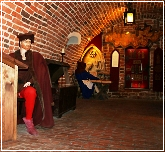 On the turn of the 20th century they were sold as Christmas tree decorations. A wood-carver carved two halves of a figurine in two pieces of wood. We can see a couple, or even several images of people or objects on long narrow boards. The boards were attached to each other with wooden pegs. Baking trays of great variety and artistic value were often made by skilled gingerbread bakers and wood-carvers. At the exhibition you can see a wood-carver's workshop reconstructed on the basis of medieval paintings and sculptures. In the next room we present stocks necessary for the preparation of gingerbread dough. Flour and honey were provided by rich agricultural region - the Chelmno Land. Exotic spices were easily available thanks to the large group of spice merchants living in Toruń. They traded in cinnamon, cloves, nutmeg, On the turn of the 20th century they were sold as Christmas tree decorations. A wood-carver carved two halves of a figurine in two pieces of wood. We can see a couple, or even several images of people or objects on long narrow boards. The boards were attached to each other with wooden pegs. Baking trays of great variety and artistic value were often made by skilled gingerbread bakers and wood-carvers. At the exhibition you can see a wood-carver's workshop reconstructed on the basis of medieval paintings and sculptures. In the next room we present stocks necessary for the preparation of gingerbread dough. Flour and honey were provided by rich agricultural region - the Chelmno Land. Exotic spices were easily available thanks to the large group of spice merchants living in Toruń. They traded in cinnamon, cloves, nutmeg, 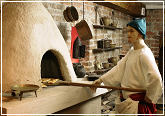 ginger, cardamom, and aniseed, all of which are presented at the exhibition next to such genuine merchant accessories as scales, weights, coins, and purses. From this room you are invited to go to a 16th century bakery, reconstructed on the basis of engravings from the period. One of the apprentices is just rolling up gingerbread dough into baking trays, another is putting them into the stove, and a helper is bringing wood. You can also see there wooden troughs, kneading-troughs, shovels, clay, straw and copper vessels, as well as buckets, barrels, and sacks. Near the oven there are bellows and a flint to light fire. According to the preserved documents, by the end of the 16th century there had been 40 bakers, including 4 gingerbread bakers. ginger, cardamom, and aniseed, all of which are presented at the exhibition next to such genuine merchant accessories as scales, weights, coins, and purses. From this room you are invited to go to a 16th century bakery, reconstructed on the basis of engravings from the period. One of the apprentices is just rolling up gingerbread dough into baking trays, another is putting them into the stove, and a helper is bringing wood. You can also see there wooden troughs, kneading-troughs, shovels, clay, straw and copper vessels, as well as buckets, barrels, and sacks. Near the oven there are bellows and a flint to light fire. According to the preserved documents, by the end of the 16th century there had been 40 bakers, including 4 gingerbread bakers. 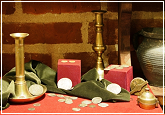 Each of them had his own workshop- a bakery. That situation had changed in Prussian times, when the number of bakers started to decrease. At the same time factories producing gingerbread in a mechanical way were established. While the traditional gingerbread making began to decline, the factories increased steadily the variety of consumer gingerbreads, reducing considerably the production of ornamental ones. That meant the deterioration of artistic gingerbread wood-carving, which was then carried on mainly by small workshops in the countryside. They made simplified baking trays presenting folk themes. Each of them had his own workshop- a bakery. That situation had changed in Prussian times, when the number of bakers started to decrease. At the same time factories producing gingerbread in a mechanical way were established. While the traditional gingerbread making began to decline, the factories increased steadily the variety of consumer gingerbreads, reducing considerably the production of ornamental ones. That meant the deterioration of artistic gingerbread wood-carving, which was then carried on mainly by small workshops in the countryside. They made simplified baking trays presenting folk themes.
|
| All rights reserved Toruń 2005-2009 | About us | CenterMedia |





